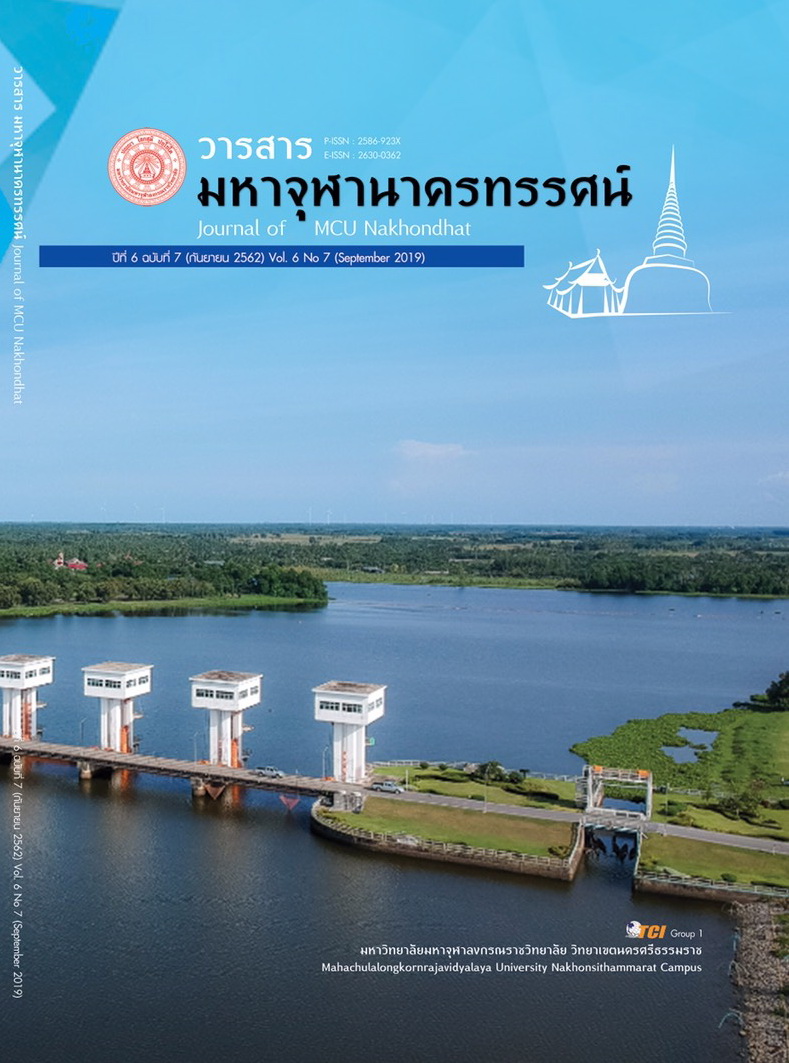THE EFFECT OF GENDER AMONG PRIMARY SCHOOL STUDENTS ENHANCING SPATIAL INTELLIGENCE USING VIRTUAL REALITY COGNITIVE TRAINING PROGRAM
Main Article Content
Abstract
The purpose of this research was to study the differences between gender with enhancing spatial Intelligence of primary school students after training with a virtual reality cognitive training program (VR-CTP). The participants were 68 Grade 5 students (male 34, female 34) in the academic year 2018 study at Anuban Chanthaburi school. The participants were trained with VR-CTP consists of 2 activities (Maze Walker, Construction Worker), 6 training levels in 10 minutes each 12 times and collecting data while conducting spatial intelligence task on a computer screen in 3 components, including spatial visualization, spatial orientation and spatial relation. The data were analyzed by using MANOVA.
The result of the implementation of the Virtual Reality Cognitive Training Program (VR-CTP). The results demonstrated that the response accuracy scores on spatial ability test of the experimental group were significantly (p<.05) increased after training. The response time on spatial ability test of the experimental group were significantly decreased after training. Male students had the response accuracy scores of being correct while doing the MRT test higher than females and there are no different in response time all paper test.
Article Details
References
Armstrong, T. (2009.). Multiple intelligences in the classroom (3rd ed.). Virginia: Alexandria.
Cohen, J. (1992). A power primer. Psychological Bulletin, 112(1), 155-159.
Dweck, C. S. (2012). Mindset: How you can fulfill your potential. London: Robinson Publishing.
Edmonds, W. A., & Kennedy, T. D. (2017). An Applied Guide to Research Designs: Quantitative, Qualitative, and Mixed Methods. California: Sage Publica tions.
Ekstrom, R. B., French, J. W., Harman, H. H., & Derman, D. (1976). Kit of factor-referenced cognitive Tests. New Jersey: Education Testing service.
Fan, Z., Mingyuan, H., Weitao, C., Hui, L., Chaoyang, F. (2018). Framework for virtual cognitive Experiment in virtual Geographic Environments. ISPRS International Journal of Geo-Information, 7(1), 36-54.
Gardner, H. (2011). Frame of mind: The theory of multiple intelligences (3rd Ed.). New York: BasicBooks.
Hoffler, T. N. (2010). Spatial ability: Its influence on learning with visualization -a meta – analytic review. Education Psychology Review, 22(3), 245-269.
Hunt, E. (2011). Where are we? Where are we going? Reflections on the Current and Future State of Research on Intelligence. New York: U. Press.
Jausovec, N., & Jausovec, K. (2012). Working memory training: Improving intelligence–changing brain activity. Brain and Cognition, 79(2), 96–106.
Kimura, D. (2000). Sex and cognition. Cambridge: MA: MIT Press.
McMillan, J. H., & Schumacher, S. (2014). Research in education: Evidence-based inquiry (7th, Pearson new international ed.). Harlow: Pearson Education.
Neuburger, S., Jansen, P., Heil, M., & Quaiser-Pohl, C. (2011). Gender differences in pre-adolescent’s mental rotation performance: Do they depend on grade and stimulus type? Personality and Individual Differences, 50, 1238–1242.
Reilly, D., Neumann, D., & Andrews, G. (2017). Gender Differences in Spatial Ability: Implications for STEM Education and Approaches to Reducing the Gender Gap for Parents and Educators. Visual-spatial Ability in STEM Education, 195-224.
Shin, D. H. (2017). The role of affordance in the experience of virtual reality learning: Technological and affective affordances in virtual reality. Telematics and Informatics, 34(8), 1826-1836.
Sorby, S. A. (1999). Developing 3-d spatial visualization skills. Engineering Design Graphics Journal, 63(2), 21-32.
Uttal, D. H., Meadow, N. G., et al. (2013). The malleability of spatial skills: A meta analysis of training studies. Psychological Bulletin, 139(2), 352-402.
Wright, K. R., Thompson, W. L., Ganis, G., Newcombe, N. S., & Kosslyn, S. M. (2008). Training generalized spatial skills. Psychonomic Bulletin & Review, 15(4), 763-771.


